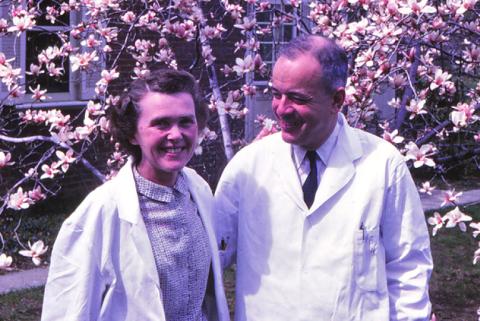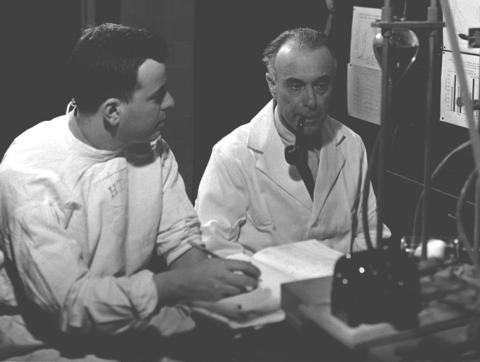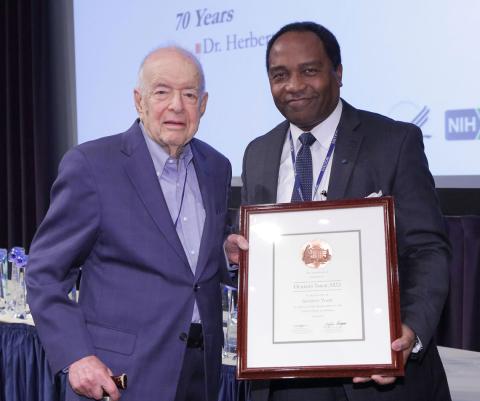Oldest Active Scientist
Life, Longevity of Tabor Celebrated

Dr. Herbert Tabor, the world’s foremost authority on the enzymatic pathways of polyamines, died on Aug. 20. He served 77 years at the National Institutes of Health, the oldest active NIH scientist ever. He was, until his death at age 101, a senior investigator in NIDDK’s Laboratory of Biochemistry and Genetics, where he had served as lab chief until 1999.
“His death is such a great loss for the NIH and broader scientific community of a warm, humble, insightful and imaginative man. Dr. Tabor was truly loved and respected by everyone who worked with him, at the NIH and beyond,” said Dr. Griffin Rodgers, NIDDK director, and Dr. Michael Gottesman, NIH deputy director for intramural research, in a message to all NIH staff after Tabor’s death.
Tabor and his wife, Celia—also an NIH physician-scientist—revealed the many functions served by polyamines, organic compounds that interact with DNA, RNA and proteins. The Tabors demonstrated that polyamines are required for growth of most organisms; protect against oxidative damage, elevated temperatures and environmental insults; and help maintain mitochondria and the fidelity of protein biosynthesis. The Tabors lived in housing on the NIH campus and raised four children.

Photo: ASBMB
“He was a consummate scientist to the very end, working remotely during the pandemic on research papers with NIH colleagues. Aside from leaving a profound scientific legacy, he was the last living voice of the NIH’s formative years, having arrived in 1943 to the then recently created Bethesda campus,” said the note from Rodgers and Gottesman.
In a 2019 oral history interview, Tabor described arriving at the Bethesda campus. “The NIH was a small place then…Here I am, a young fellow just out of school, and what do I do? I receive orders to report to the commanding officer. So, I go up to Bldg. 1—to show how different things were then—and I go into the NIH director’s office and say: ‘Here I am.’”
Tabor was born in New York City on Nov. 28, 1918, in the midst of the flu pandemic. He grew up during the Great Depression and attended public schools. He received his undergraduate degree from Harvard University in biochemical science in 1937 and medical degree from Harvard in 1941.

Photo: Claire Johnson
Tabor’s oldest son, Dr. Edward Tabor, recalled, “My father was dedicated to working at the lab bench up until the last year of his life and he spent time every day at the bench. When I was growing up, he and my mother worked together in the evenings and weekends, writing papers about their own work, writing scientific review articles and working on editing the journal as well as several volumes in the Methods in Enzymology series. Their example was a way of teaching and I learned a lot about a life in science just by watching how much they enjoyed the work they did together.”
Tabor’s influence went beyond his family and NIH.
During an internship at Yale New Haven Hospital in 1942, Tabor saw both the clinical and biochemical worlds. This included the first clinical use in the country of penicillin, a drug that would prove crucial in saving the lives of soldiers fighting in what would soon be labeled World War II. He assisted in the first administration of penicillin in the United States, curing a deadly case of streptococcal septicemia.
In 1943, during WWII, Tabor entered the Public Health Service and became the sole medical officer on the USCGC Duane, a Coast Guard cutter that sailed between the U.S. and England, guarding convoys bringing supplies to the British Isles. After one battle at sea, when the Duane sank a German submarine and captured its crew, Tabor provided medical care to rescued Allied sailors whose ship had just been sunk by the submarine as well as to captured German sailors.

Photo: ASBMB
As that year wound down, Tabor was transferred to NIH, working under the supervision of Dr. Sanford Rosenthal, chief of the Laboratory of Pharmacology and Toxicology at the National Institute of Arthritis and Metabolic Diseases, now called the National Institute of Diabetes and Digestive and Kidney Diseases. Together they studied electrolyte changes in burns and traumatic shock and determined how to treat such injury using saline instead of plasma, as plasma was in short supply.
No summary of Tabor’s achievements is complete without note of his leadership of the Journal of Biological Chemistry. He joined the JBC editorial board in 1961, became associate editor in 1968, and editor-in-chief in 1971, a position he held until 2010. Tabor oversaw the journal’s expansion from 1,000 to 4,500 published articles per year and he was the moving force behind its transition to online publishing in 1995. He also created the Minireview Compendium, a yearly compilation of all short reviews published in the JBC.
In 2011, in honor of Tabor’s scientific and editorial legacy, the JBC established the Dr. Herbert Tabor Young Investigator Awards to recognize early-career first authors of standout JBC papers for their creativity and scientific excellence. Similarly, the Dr. Herbert Tabor Research Award from the American Society for Biochemistry and Molecular Biology (ASBMB), established in 2004, honors senior investigators.
“Herb left a legacy like none other in JBC’s history,” said Dr. Lila Gierasch, editor-in-chief of JBC. “Were it not for Herb, I don’t know what the journal, and the molecular bioscience he helped it shepherd, would look like today.”

Photo: Bill Branson
Tabor’s honors are many. He received the Arthur S. Flemming Award in 1956; received the PHS Meritorious Service Medal in 1970; was elected to the American Academy of Arts and Sciences in 1971; was elected to the National Academy of Sciences in 1977; received the Hillebrand Prize from the American Chemical Society in 1986; and he and Celia received the William C. Rose Award from the ASBMB in 1994. In honor of his 100th birthday, Montgomery County proclaimed Nov. 28, 2018, as Dr. Herbert Tabor Day.
Dr. Urs Ruegg, who worked at NIH in the 1970s, recalls staying briefly with the Tabors in their campus home in later years. “I will always remember how in the mornings, a bag with manuscripts that were assembled the day before arrived on their front porch with a big noise. At about 6 a.m., Herb would go and get that bag, in which there were about 50 bundles of papers, and decided which co-editor or associate editor would get which manuscript for further handling and review. I was always very impressed with this activity and the intensity of the way Herb talked and carried out science.”
Tabor was a prolific mentor of other scientists. One of many mentees is Dr. Reed Wickner, who trained under Tabor and succeeded him as chief of the Laboratory of Biochemistry and Genetics in 1999.
“Dr. Tabor taught me how to do science, and his devotion to science set a standard for me to aspire to,” Wickner said. “His gentle sincerity combined with forthright critical thinking made him a leader throughout his career.”
Tabor is survived by four children—Edward, Marilyn, Richard and Stanley—as well as 10 grandchildren and 6 great-grandchildren.
The ongoing Covid-19 pandemic has limited the family’s ability to hold memorial services. In lieu of flowers, donations are welcome in Tabor’s name to the Children’s Inn at NIH.
